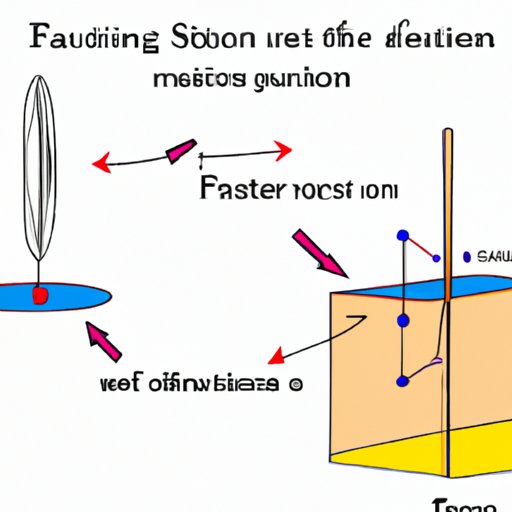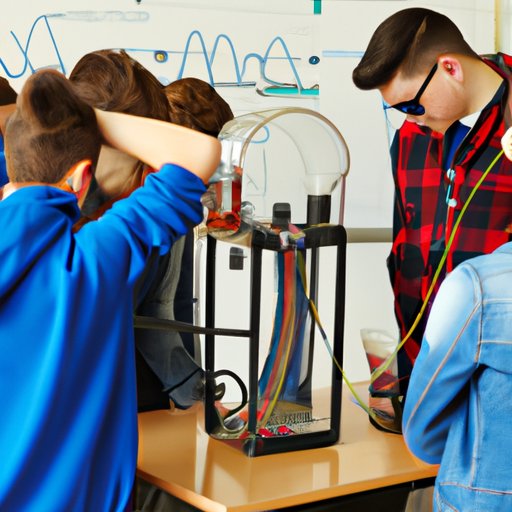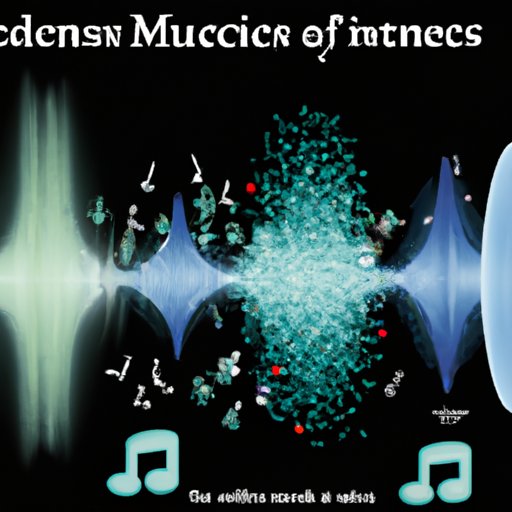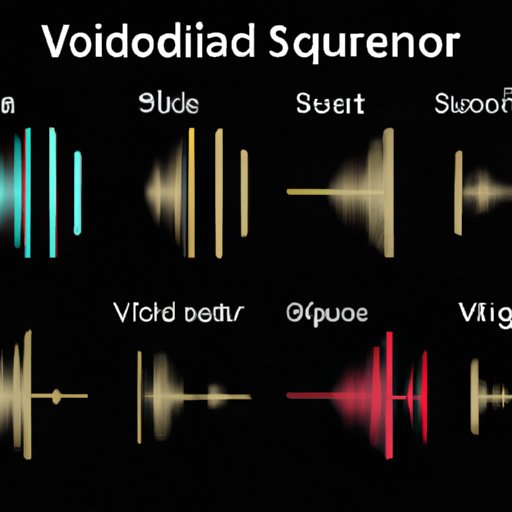Introduction
Sound is a form of energy that propagates as waves through a medium. This process is known as sound propagation and is a fundamental concept in physics. In this article, we will explore the various aspects of sound propagation, including the physics involved, the different types of media it affects, and the role of temperature, vibrations, and frequency in sound transfer.

Explaining the Physics of Sound Propagation
The basic physics behind sound propagation is relatively simple. Sound is created when a vibrating object causes particles in the medium to move in a periodic fashion. These particles then transmit the vibration through the medium, creating a series of compressions and rarefactions known as a sound wave.
Describing Wave Motion
In order to understand sound propagation, it is important to first understand the basics of wave motion. A wave is a disturbance in a medium that transfers energy from one point to another without transferring matter. Sound waves are longitudinal waves that travel in the form of alternating compressions and rarefactions.
Examining Pressure Variations
The amplitude of a sound wave is determined by the amount of pressure variation between its compressions and rarefactions. The higher the pressure variation, the louder the sound. Conversely, the lower the pressure variation, the quieter the sound.
Understanding Acoustic Impedance
Acoustic impedance is a measure of how easily a medium can transmit sound. It is determined by the density and elasticity of the medium. Higher densities and higher elasticities result in higher acoustic impedances, which allow for better sound transmission.
Examining Different Types of Media and How They Affect Sound Travel
Sound can propagate through a variety of mediums, including solids, liquids, and gases. Each medium has its own unique properties that can affect the way sound travels through it. Let’s take a look at some of these properties and how they affect sound transfer.
Investigating Solid, Liquid, and Gas Mediums
Solid mediums are generally the best conductors of sound because they have high densities and high acoustic impedances. Liquids are also good conductors of sound, though not as good as solids. Gases, on the other hand, are poor conductors of sound due to their low densities and low acoustic impedances.
Exploring the Impact of Viscosity and Density on Sound Transfer
The viscosity and density of a medium can also affect sound transfer. In general, higher viscosities and densities lead to better sound transmission, while lower viscosities and densities can impede sound transmission. For example, water is a better conductor of sound than air because it has a higher viscosity and density.

Investigating the Role of Temperature in Sound Transfer
Temperature can also have an effect on sound propagation. As temperature increases, the speed of sound increases. This is because the molecules in the medium become more energetic and collide more often, resulting in a greater number of compressions and rarefactions.
Examining How Heat Affects Sound Waves
Heat can also affect the amplitude of sound waves. As temperature increases, the amplitude of the sound wave decreases. This is due to the fact that the molecules in the medium spread out as they become more energetic, resulting in weaker compressions and rarefactions.
Analysing Temperature’s Impact on Velocity and Frequency
Temperature can also affect the velocity and frequency of sound waves. As temperature increases, the velocity of the sound wave increases. At the same time, the frequency of the sound wave decreases. This is due to the fact that the molecules in the medium become more energetic and collide more often, resulting in a lower frequency.
Demonstrating How Vibrations Impact Sound Transfer
Vibrations can also have an effect on sound propagation. Vibrations can cause resonance and standing waves, which can affect the speed and direction of sound waves. They can also cause reflection, refraction, and diffraction, which can alter the shape and intensity of sound waves.
Exploring Resonance and Standing Waves
Resonance occurs when the frequency of a vibrating object matches the natural frequency of the medium. This causes the medium to resonate, amplifying the sound waves and resulting in an increase in sound intensity. Standing waves, on the other hand, occur when two sound waves of opposite directions combine to create a stationary wave pattern.
Examining the Effects of Reflection, Refraction, and Diffraction
Reflection occurs when a sound wave bounces off a solid surface. This can cause the sound wave to change direction and intensity. Refraction occurs when a sound wave passes through a medium with different densities, causing the wave to bend. Diffraction occurs when a sound wave passes through an opening, causing the wave to spread out in multiple directions.

Analysing the Effects of Frequency on Sound Transmission
Frequency also plays an important role in sound transmission. The frequency of a sound wave determines its wavelength, which in turn affects its speed and intensity. The higher the frequency, the shorter the wavelength and the faster the sound wave travels.
Highlighting the Relationship Between Frequency and Wavelength
The relationship between frequency and wavelength is described by the equation v = fλ, where v is the speed of sound, f is the frequency, and λ is the wavelength. This equation shows that as frequency increases, wavelength decreases, and vice versa.
Discussing the Inverse Square Law
The inverse square law states that the intensity of a sound wave is inversely proportional to the square of the distance from its source. In other words, the intensity of a sound wave is reduced by half for every doubling of the distance from its source. This explains why sound becomes quieter as you move further away from its source.

Understanding the Interaction between Sound and Particles
The interaction between sound and particles can also affect sound propagation. Particles can absorb sound waves, resulting in sound attenuation. Particles can also cause the Doppler effect, which is a change in frequency caused by the relative motion of the source and receiver.
Examining the Doppler Effect
The Doppler effect occurs when a sound wave is emitted from a moving source. If the source is moving toward the receiver, the frequency of the sound wave will appear to be higher than it actually is. Conversely, if the source is moving away from the receiver, the frequency of the sound wave will appear to be lower than it actually is.
Exploring Sound Absorption and Attenuation
Particles can also absorb sound waves, resulting in sound attenuation. This is the decrease in intensity of a sound wave as it travels through a medium. The degree of attenuation depends on the type of medium, the frequency of the sound wave, and the distance it has traveled.
Comparing the Speed of Sound in Different Media
The speed of sound is affected by the type of medium it is traveling through. Generally speaking, sound travels faster through solid mediums than it does through liquid or gas mediums. It also travels faster in warmer temperatures than in cooler temperatures.
Comparing Air to Water and Solid Mediums
The speed of sound in air is approximately 343 m/s, while the speed of sound in water is approximately 1482 m/s. The speed of sound in solids can vary greatly depending on the material, but it is typically much higher than it is in air or water. For example, the speed of sound in steel is approximately 5100 m/s.
Considering Temperature Effects on the Speed of Sound
Temperature also affects the speed of sound. As temperature increases, the speed of sound increases. This is due to the fact that the molecules in the medium become more energetic and collide more often, resulting in a greater number of compressions and rarefactions.
Conclusion
In this article, we have explored the physics behind how sound travels through a medium. We have discussed the various aspects of sound propagation, including the physics involved, the different types of media it affects, and the role of temperature, vibrations, and frequency in sound transfer. We have also compared the speed of sound in different media and examined the interaction between sound and particles. Finally, we have highlighted the importance of understanding sound propagation in order to effectively use sound in applications such as music production, audio engineering, and acoustics.
Summary of the Topics Discussed
In this article, we have explored the physics behind sound propagation, including wave motion, pressure variations, acoustic impedance, and the effects of different types of media on sound transfer. We have also investigated the role of temperature, vibrations, and frequency in sound transmission, as well as the interaction between sound and particles. Finally, we have compared the speed of sound in different media.
Final Thoughts
Understanding the physics of sound propagation is essential for anyone working in sound production, audio engineering, or acoustics. By understanding the various factors that affect sound transmission, one can effectively use sound to create art, enhance music, and improve acoustics.
(Note: Is this article not meeting your expectations? Do you have knowledge or insights to share? Unlock new opportunities and expand your reach by joining our authors team. Click Registration to join us and share your expertise with our readers.)
